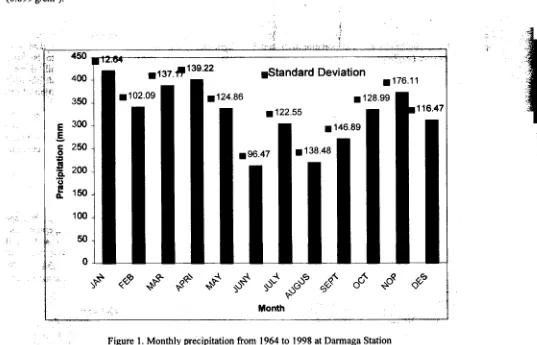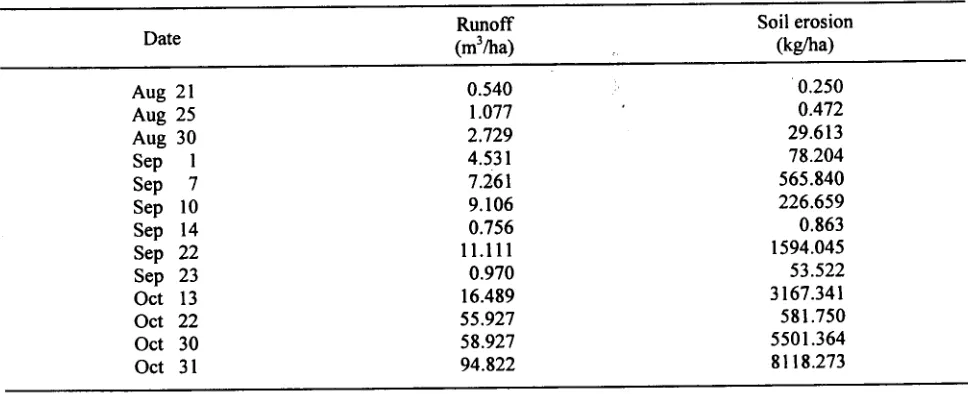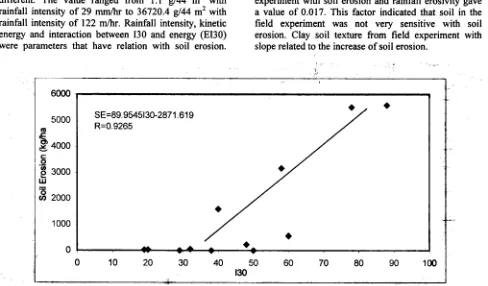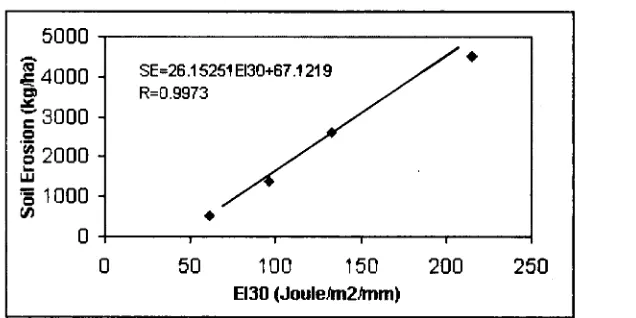--~.-,f
Bul. Agron. (31) (2) 71- 79 (2003)
[-I
The Effect of Rainfall Intensity on Soil Erosion and Runoff
for Latosol Soil in Indonesia
,j",;"
.. Sukandi Sukartaatmadjal), Yohei Satol), Eiji Yamajf), Masaya Ishikawa3) ";,1~.;;"
,~ ABSTRACT
Soil erosion is the most serious problem of land degradation in Indonesia. However, limited report has been
documented. The erosion problem in Indonesia, particularly in Java, has been at an alarming rate. The fundamental
case of soil erosion is the rain effect upon the soi/. Rainfall intensity and soil characteristics are related to soil erosion and runoff The objective of this research was to study the relationship of rainfall intensity, soil erosion and runoff in latosol soi/. An experiment was conducted using plot size 22 m in length and 2 m in width and 9 % slope. A field
experiment was conducted with rainfall intensity observation for 3 months, to collect soil erosion and runoff in the soil
collector. A laboratory experiment was done using rainfall simulator instruments with rainfall intensity of 2.3, 3.4, 4.5,
5.6 cm/hr and 8 % slope each with 3 replications. The result of the experiments showed that soil erosion was 3.14 t/ha
and runoff was 33.20 m3/ha. When the rainfall size increased the soil erosion and runoff also increased. The correlation
coefficient between £130 (Interaction 130 and energy) and soil erosion was positive.
Key Words: Rainfall intensity, Soil erosion, Latosol soil "
INTRODUCTION in erosive soil, steep slopes and poor land management
in Indonesia can cause serious soil erosion and water
Soil erosion is the removal of soil from land pollution (Arsjad, 1989).
surface by running water (Schwab et a/., 1981). It is a Latosol soil in Indonesia is important for
process of soil detachment and transportation from soil agriculture, but soil erosion especially in land with
agent of erosion (Arsjad, 1989). While it is generally slopes, and high rainfall intensity tends to be high.
acknowledged that erosion is serious in Indonesia, no Therefore, it need protection from soil damage
, analytical or systematic studies have been undertaken to (Sukartaatmadja, 1992). Research on rainfall intensity,
i
document watershed; records of 6.0 mm/year and 1.7 soil erosion and runoff is needed for protection of soilI ml?/year were calculated from sediment concentration from erosion damage (F AO, 1965).
I
(Smukaban, 1989). The purpose of this research was to study ther. Under intense tropical condition with large amount effect of rainfall intensity on soil erosion of latosol. The
I of rainfall, severe soil erosion results (Barus and most important characteristic of soil in relation with soil
Suwardjo, 1977). The situation is aggravated by the erosion was erodibility. The research was to determine
rough terrain and steep topography in the mountainous the value of soil erodibility.
area of Java, Sumatera, Sulawesi, The Lesser Sunda Island and Irian (Sinukaban, 1989). Thus erosion
damage resulting from floods occurs widespread in MATERIALS AND METHODS
Indonesia (Bams and Suwardjo, 1977).
Rainfall is high during wet season, which results in Plot size of 22 m x 2 m and land with 9 % slope
increase of soil erosion (Hardjowigeno, 1989). Large was used for field experiment. The field experiment had
area of latosol is found in Cisadane Watershed. Most of a soil collector for measuring soil erosion and runoff
land is used for agriculture. Total critical land in after each precipitation. The experiment was conducted
Cisadane Watershed is 14733 ha and mostly situated in at the experiment station, Bogor Agricultural
Bogor District (Sukartaatmadja, 1992). Intense rainfall
I) Senior Lecturer, Bogor Agricultural University, Indonesia 2) Professor, The University of Tokyo, Japan
.. 3) Assistant Professor, The University of Tokyo, Japan
71
.~;~ I_I~~ ~"j:~';f~:f. ~,,;.-;~,
" ," ,i
,
;11 ~
1
j: Bul. Agron. (31) (2) 71- 79 (2003) ~t~;;' ~ t~
.1 ~
c
J
University, Darmaga, Bogor, Indonesia. Observation of Rainfall erosivity was calculated using formula E
;; rainfall in the location was done in 3 months. = 13.32 + 9.78 log I and EI = E x 130, and Re = EI x 10.
; A laboratory experiment was done to identify 2 where E= Kinetic energy of rainfall (Joule/m2/mm), I
relationship between rainfall and soil erosion, and = Total Rainfall (mm) , EI = Index of potential erosion,
control for experiment in the field. The result of 130 = Rainfall intensity maximum 30 minutes (cm/hr),
laboratory experiment was used to estimate field Re = Rainfall erosivity. Soil erodibility was calculated
experiment, Rainfall simulator instrument with rainfall using formula K = AIR x LS x CP where K = Soil
intensity 2.3, 3,4, 4.5 and 5,6 cm/hr and land slope of 8 erodibility, A = soil loss (ton/ha/year), R = Erosivity
% was used. Soil samples were taken from latosol soil factor, K = Erodibility factor, LS = Slopes factor and
at Darmaga, Bogor, LS= Land management factor. The rainfall was
Soil ~ample box 30 cm in width, 59:5 cm in length mea~ured at D~a~a station wi~ latitude of 60 °30! S,
and 5 cm In depth was then prepared, Soil collector was longitude of 106 45 E, and elevation of 250 m.
used for measurement of soil erosion and runoff. Time
, of experiment for each replicate was one hour. Before
i
treatment of soil sample it was set in field capacity RESULTS AND DISCUSIONi condition, Soil infiltration in the box of soil sample
needed time and runoff was collected in the soil and Precipitation and Erosivity
water collector. Experiment of soil erosion in theI b d . M f
. .
tat. t D 294 I~
II
'I
. h
d.ffi . ~ II ean 0 preclpl Ion a armaga was . mma oratory use raInla slmu ator wit I erent raInla th Th h' h t thl
. .
tat. ,.. ,. . . per mon. e Ig es mon y preclpl Ion was In
Intensity, The soil erosion was collected In soil collector N b h.1 th I t thl ' .t t .
d . h d
.
d' . Th 'I th dr. d ovem er, w lee owes mon y preclpl a Ion wasi' an welg e In wet con Itlon. e SOl was en Ie, " . . fi
i . S .1 . I d b I 8 S 'Ib Ik In July. Monthly precipItation at Darmaga station rom
, In oven, 01 partlC es use was e ow mm, 01 u I 964t 1998. h ' F
.
I
.
d . d' , fi fi Id ' 0 IS S own In Igure ,
enslty was same con Itlon as or Ie experIment
; (0.899 g/cm3).
,
I \
j
~'
,. t
.Standard Deviation
j
;
j
,
~
~
~ ~ ~ ~-,,~
~
-,,~ ~~
~'"
r~
~. ~ ~ '$ '$ ~v
~ Month
Figure 1, Monthly precipitation from 1964 to 1998 at Darmaga Station
72 Sukandi Sukartaatmadja, Yohei Sato, Eiji Yamaji, Masaya Ishikawa
[image:2.611.55.592.381.726.2]- -: :~-- - -.-,-"..
l
Bul. Agron. (31) (2) 71-
79 (2003)Table 4. Soil physic and organic matter from field experiment.
Soil physic and soil organic matter Mean
Bulk density (depth of soil 0-15 cm) (g/cm3) 0.899
.
Texture (%)Clay 70.715
i
Loam
23.740
;J,.
Sand
5.545
Organic Matter (%)
C 1.860
N 0.195
C/N 9.500
Soil bulk density of field experiment 0.899 g/cm3 increased capacity of cation exchange. (Hardjowigeno,
indicated comparison between soil dry weights with soil 1989).
volume. An increase of soil bulk density caused The result of measurement on soil infiltration was:
condition of soil compaction and related with 1c = 1.241 to,17 Ir = 12.65 t-183
infiltration and root growth. The value of soil bulk Where Ic = Infiltration accumulation ( cm)
density lower than 1 caused easy water to flow through Ic = Rate of infiltration ( cm/hr)
the soil (Hardjowigeno, 1989). 1 T
= time (minute)
Soil texture of field experiment was clay loam. ;
With 40% - 60% clay, the soil was very sensitive to soil Runoff and Soil erosion
erosion. The stability of soil depends on clay mineral. . . Runo an SOl erosIon were measure a erff d .1 ' d ft
(Morgan, 1979). The soIl was not good as IndIcated by
.
~II
.
.
1 II t
R
ff
d .1.
fr
. ., 0" ramla m SOl co ec or. uno an SOl erosIon om
organIc matter m the soIl lower than 10 Yo. SoIl erosIon fi Id . fi 3 th b .. h .
d ff Id d'I ' tt (M 'IIIe expenm~nt or mon s 0 servatlon IS s own m
an runo cou ecrease SOl organIc ma er I ar T bl 5
and Turk, 1986). High organic matter and soil clay a e .
Table 5. Runoff and Soil erosion from field experiment in 1990.
Date Runoff Soil erosion
(m3/ha) , (kg/ha)
Aug 21 0.540 0.250
Aug 25 1.077 0.472
Aug 30 2.729 29.613
r Sep 1 4.531 78.204
I Sep 7 7.261 565.840
Sep 10 9.106 226.659
Sep 14 0.756 0.863
Sep 22 11.111 1594.045
Sep 23 0.970 53.522
Oct 13 16.489 3167.341
., Oct 22 55.927 581.750
Oct 30 58.927 5501.364
i
Oct 31 94.822 8118.273~
The Effect of Rainfall Intensity on Soil Erosion ..", 75
i
!
[image:5.611.77.565.122.257.2] [image:5.611.82.566.471.668.2]Bul. Agron. (31) (2) 71
-
79 (2003)100
90
.
80 RO=0.9531 130-29,788
'(U' 70 R=0.9341
J::
M 60 E
;;;-50
~
40~
~
30
20
10
i
0 0 20 40 60 80 100 120 140
l
130 ~
!
I:; Figure 4. Relation between 130 and runoff from field experiment
':
,
,
"'
The lowest runoff from field experiment
is 0.540
'Total soil erosion of 3 months
observation
was 24.99
m3!ha and the highest is 94.792 m3!ha. Runoff occurred :t/ha. The relation between 130 and soil erosion in field
after sufficient water infiltration. Runoff influenced soil experiment is shown in Figure 5.
erosion. Relation of rainfall intensity 30 minutes (130) The rainfall from August to October was normal
and runoff is shown in Figure 4. Runoff depended on but was not the maximum in the wet season. Soil
130 because rainfall intensity 30 minutes increased erosion was higher in the wet season. If it is higher than
runoff (Morgan, 1979). 12.3 t/ha/year, it will have detrimental to land resources
The result of soil erosion from each rainfall was (F AO, 1965). Observation of soil erodibility in the field
different. The value ranged from 1.1 g/44 m2 with experiment with soil erosion and rainfall erosivity gave
rainfall intensity of 29 mm/hr to 36720.4 g/44 m2 with a value of 0.017. This factor indicated that soil in the
rainfall intensity of 122 m/hr. Rainfall intensity, kinetic field experiment was not very sensitive with soil
energy and interaction between 130 and energy (EI30) erosion. Clay soil texture from field experiment with
,
!
were parameters
that have relation with soil erosion.
slope
related
to the increase
of soil erosion.
~, .; ~
---i,
~ 6000
.
5000
S:=89.9545130-2871
,619
.:1
icu R-0.9265 "
~
4000c
0
.~ 3000
""
w
=
,
~ 2000 :
I : :
1000
.
[
~0
0 10 20 30 40 50 60 70 80 90 100 :1 ..?
[image:6.611.134.501.99.297.2]130 ,
Figure 5. Relation between 130 and soil erosion from field experiment
76 Sukandi Sukartaatmadja, Yohei Sato, Eiji Yamaji, Masaya Ishikawa
[image:6.611.74.562.442.728.2]~
-
.- - cc'~\1R"~ - ~--~Bul. Agron. (31) (2) 71
-
79 (2003)I
Table 6. Runoff from rainfall simulator (m3/ha).Rainfall L d I Replicates
.. an s ope
M
intensIty (0;<) l ean
~ (cm/hr) 0 2 3
2.3 8 1.01 1.39 1.33 1.22
3.4 8 23.98 26.38 25.32 25.21
~ 3.5 8 52.99 58.46 55.45 55.61
5.6 8 172.93 193.01 182.97 182.97
Total of soil sample 12
The result of runoff from rainfall simulator The result of runoff value, was affected not only by
instrument is shown in Table 6. Each experiment was rainfall, but also by soil characteristic. In laboratory
run for 1 hour. The same land slope and rainfall experiment even, soil under disturbances soil the rainfall
intensity with the field experiment were measured by has effect on runoff. Runoff influenced soil texture and
rain gauge instrument. The increase of rainfall intensity soil erodibility (Schwab et a/., 1981). Runoff from
increased amount of runoff. Excess of rainfall after latosol soil was higher than regosol soil, because of their
evaporation and infiltration was important for water different soil characteristics. Trend of increasing runoff
resources (Arsjad, 1989). with rainfall intensity was the same in podzolic soil. The
The lowest runoff 1.22 mV1785 cm2 was observed result in podzolic soil showed that increasing rainfall
with rainfall intensity of 2.3 cm/hr. Soil in sample box; intensity caused runoff to increase (Sukartaatmadja,
has bulk density nearly same in the field experiment. 1983).
Table 6. Runoff from rainfall simulator (m3/ha).
..
Rainfall L d I Replicates
.. an s ope
M
I
intensIty(cm/hr)
(0;<) ean0
1
2
3
I
2.3 8 113.20 169.80 226.40 169.80
3.4 8 1528.20 1245.20 1358.40 1377.23
3.5 8 2773.40 2264.00 2773.40 2603.60
5.6 8 4131.80 4188.40 5207.20 4509.13
Total of soil sample 12
The result of soil erosion from rainfall simulator is of soil particle. However, an increase of transportation
shown in Table 7. Mean of soil erosion with rainfall is related to decrease of soil particle size. Therefore
! intensity of 2.3 cm/hr was 3.0 g/1785 cm2. With the latosol soil with clay texture is difficult to disperse
increase of rainfall intensity, mean of soil erosion also compared to sand texture (Morgan, 1979). Soil with
increased. Runoff also increased. It means that soil clay texture is easily suspended by rainfall, soil
erosion also depends on rainfall intensity. Soil particle compacted, and runoff increased. Soil erosion has
1
erodes after dispersion by rainfall energy and relation with EI30 and it is shown in Figure 5 Effect oftransportation by runoff (Hudson, 1981). increase EI30 to soil erosion was positive. Soil erosion
Soil texture is a function of soil erosion can be predicted with EI30.
occurrences. Soil dispersion increases with the increase
":t,
-;
'\
..
I
The Effect of Rainfall Intensity on Soil Erosion 77
I
[image:7.611.84.567.123.219.2][
: ., ..
Bul. Agron. (31) (2) 71
-
79 (2003),.0
5000
.
i4000
SE=26.15251EI30+67.1219=
R=O.9973~
'C" 3000 -'.,
C
'~ 2000
~
w
:g
1000
(/)
.
0
0
50
100
150
200
250
[image:8.627.162.480.108.267.2]EIJO
(JouleIm2Imm)
Figure
6. Relation
between
soil erosion
and EI30 from laboratory
experiment
D' . soil
Permeabili ty are influenced by soil erodibility.
ISCUSSlon .
d Latosol soil has the lowest K than podzollC, regosol an The rainfall has a power for soil det~chment. This grumosol soil. However, land slope, vegetation, land
power is higher than runoff for tr:ansportatlon: There:ore use in upper Cisadane Watershed may contribute for
rainfall has a potential funct!on for soil ero.slon. high soil erosion.
(Hardjowigeno, 1989). RelatIon between raInfall From the experiments, it can be concluded
intensity and kinetic energy is apparent. '1. Mean of runoff and soil erosion on latosol soil were
E = 13.32 + 9.78 log 1 33.20 m3/ha and 3.14 tlha respectively. Increase of
and rainfall intensity increased runoff. Soil erodibility
Re = EI30 / 100 (K) from latosol soil was 0.017.
Where: E = Kinetic.Energy Goule/m2/rnrn) 2. The equati~n of relation between EI30 and soil
I = Total raInfall (rnrn) erosion is as follows:
130 = Rainfall intensity maximum 30 minutes S.E = 26.152 El 30 - 67.1219
(crn/hr) R = 0.9973
Re = Rainfall Erosivity Where: S.E = Soil Erosion (kg/ha)
EI 30 = Interaction between 130 and energy
Field experiment and laboratory experiment. ~as (Joule/m2/rnrn)
the same trend of soil erosion and runoff. The condItIon R2= Coefficient correlation
I
of soil depth in the laboratory experiment caused runoff 3. The rainfall in Bogor area is high. Runoff and soilmore higher runoff. However, no different was observed erosion will also be high. Therefore, latosol soil
for soil erosion. Rainfall erosivity (Re) is a parameter needs conservation. Upland in upper Cisadane
for estimating soil erosion (Wischmei.er an~ Smith, Watershed (73% of which is latosol soil) has a high
1978). Rainfall intensity, runoff and soil erosIon ~om priority for soil conservation program.
this experiment was positively correlated. A coefficIent 4. The equation of accumulative infiltration and rate
l
of correlation higher than 0.80 was found. Lembaga of infiltration are:Penelitian Tanah reported relation of rainfall with soil Ic = 1.24 to. I? and lr = 12.65 rl83
erosion. The rainfall parameter was used for estimating Where: Ic = infiltration accumulation (cm)
;
soil erosion. EI30 have good parameter for estimating Ir = Rate of infiltration (crn/hr):
soil erosion
and runoff and also have.
higher coe.mcie~t
t = time (minute)
of correlation.. In tropical country like IndonesIa, soil
I erosion by water caused soil degradation. .Soil e~osion. is
I disadvantageous for agriculture land. Ramfall IntensIty ACKNOWLEDGEMENT
has a function for identifying relation to soil erosion.
From the rainfall figure it can be learned about rainfall The authors wish to express their deepest
intensity, total rainfall, kinetic ~nergy and its relation to appreciation to Prof. Dr. Ir. H. Soedodo Hardjoamidjo)o
soil erosion (Barns and SuwardJo, 1977). MSc for his help in finishing this research. SpecIal
Soil erodibilitity (K) from this research was 0.017. thanks are also conveyed upon Dr.Ir .H.Moh Azron
It means total soil loss every year per unit of index soil Dhalhar MSAE and Prof. Dr. H. Kamaruddin Abdullah
erosion rainfall from land without crop (bare soil), from B~gor Agricultural University for their help and
,I without so~l conservation, ? % of land ~lope and 22 m support in this paper. To JICA, thanks for helping with
;: length. Soil texture, organIc matter, soil structure and some facility in project infra structure for IPB.
Sukandi Sukartaatmadja, Yohei Sato, Eiji Yamaji, Masaya Ishikawa
78
~",;"'~
~
---Bul. Agron. (31) (2) 71
-
79 (2003)REFFERENCES Morgan, R.P.C. 1979. Soil Erosion. Longman Inc. New
York. Arsjad, S. 1989. Konservasi Tanah dan Air. JICA Japan
and Institut Pertanian Bogor Press, Bogor. Schwab, G.O., R.K. Frevert, T.M. Edminster, R.K.
Barnes. 1981. Soil and Water Conservation
Barus, A. Suwardjo. 1977. Relation between rainfall Engineering. John Wiley and Sons Inc. New York.
and erosion. Paper in Soil Science Congress II. 1-4
~ August. Yogyakarta. Sinukaban, N. 1989. Land Degradation on Various
Fanning System in Indonesia Paper Presented on
FAa. 1965. Soil erosion by water-some measurement ISACDESA. Jakarta.
for its control on cultivated lands. FAa
Agricultural Development Paper. Rome. Sukartaatmadja, S. 1992. Prediction of erosion in Upper
Cisadane Watershed. Report on Joint Research.
Hudsons, N. 1981. Soil Conservation. Cornell JICA-DGHE/IPB Project: JTA-9a (132) Bogor.
University Press Ithaca. New York.
Sukartaatmadja, S. 1983. Pengaruh pembukaan lahan
Hardjowigeno, S. 1989. Ilmu Tanah. PT Mediyatama alang-alang terhadap erosi dan aliran pennukaan.
Sarana Perkasa. Jakarta. Thesis for Master Degree at Bogor Agricultural
Univesrsity. Millar, C.E., L.M. Turk. 1986. Fundamental of Soil
Science Second Ed John Wiley and Sons, Inc. New Wischmeier, W.H, D.D. Smith. 1978. Predicting
York. Rainfall Erosion Losses. A Guide to Conservation
Planning US Department of Agriculture.
Agrgriculture Handbook No. 537.
,
.
\.!
,; ,,;;;..~ ~,1 ""i,;;-'i
, ,;;;c~.j
:t;
'" ,;-f
;f
- -.
.
t
:4i!
, The Effect of Rainfall Intensity on Soil Erosion 79
--~.-,f
Bul. Agron. (31) (2) 71- 79 (2003)
[-I
The Effect of Rainfall Intensity on Soil Erosion and Runoff
for Latosol Soil in Indonesia
,j",;"
.. Sukandi Sukartaatmadjal), Yohei Satol), Eiji Yamajf), Masaya Ishikawa3) ";,1~.;;"
,~ ABSTRACT
Soil erosion is the most serious problem of land degradation in Indonesia. However, limited report has been
documented. The erosion problem in Indonesia, particularly in Java, has been at an alarming rate. The fundamental
case of soil erosion is the rain effect upon the soi/. Rainfall intensity and soil characteristics are related to soil erosion and runoff The objective of this research was to study the relationship of rainfall intensity, soil erosion and runoff in latosol soi/. An experiment was conducted using plot size 22 m in length and 2 m in width and 9 % slope. A field
experiment was conducted with rainfall intensity observation for 3 months, to collect soil erosion and runoff in the soil
collector. A laboratory experiment was done using rainfall simulator instruments with rainfall intensity of 2.3, 3.4, 4.5,
5.6 cm/hr and 8 % slope each with 3 replications. The result of the experiments showed that soil erosion was 3.14 t/ha
and runoff was 33.20 m3/ha. When the rainfall size increased the soil erosion and runoff also increased. The correlation
coefficient between £130 (Interaction 130 and energy) and soil erosion was positive.
Key Words: Rainfall intensity, Soil erosion, Latosol soil "
INTRODUCTION in erosive soil, steep slopes and poor land management
in Indonesia can cause serious soil erosion and water
Soil erosion is the removal of soil from land pollution (Arsjad, 1989).
surface by running water (Schwab et a/., 1981). It is a Latosol soil in Indonesia is important for
process of soil detachment and transportation from soil agriculture, but soil erosion especially in land with
agent of erosion (Arsjad, 1989). While it is generally slopes, and high rainfall intensity tends to be high.
acknowledged that erosion is serious in Indonesia, no Therefore, it need protection from soil damage
, analytical or systematic studies have been undertaken to (Sukartaatmadja, 1992). Research on rainfall intensity,
i
document watershed; records of 6.0 mm/year and 1.7 soil erosion and runoff is needed for protection of soilI ml?/year were calculated from sediment concentration from erosion damage (F AO, 1965).
I
(Smukaban, 1989). The purpose of this research was to study ther. Under intense tropical condition with large amount effect of rainfall intensity on soil erosion of latosol. The
I of rainfall, severe soil erosion results (Barus and most important characteristic of soil in relation with soil
Suwardjo, 1977). The situation is aggravated by the erosion was erodibility. The research was to determine
rough terrain and steep topography in the mountainous the value of soil erodibility.
area of Java, Sumatera, Sulawesi, The Lesser Sunda Island and Irian (Sinukaban, 1989). Thus erosion
damage resulting from floods occurs widespread in MATERIALS AND METHODS
Indonesia (Bams and Suwardjo, 1977).
Rainfall is high during wet season, which results in Plot size of 22 m x 2 m and land with 9 % slope
increase of soil erosion (Hardjowigeno, 1989). Large was used for field experiment. The field experiment had
area of latosol is found in Cisadane Watershed. Most of a soil collector for measuring soil erosion and runoff
land is used for agriculture. Total critical land in after each precipitation. The experiment was conducted
Cisadane Watershed is 14733 ha and mostly situated in at the experiment station, Bogor Agricultural
Bogor District (Sukartaatmadja, 1992). Intense rainfall
I) Senior Lecturer, Bogor Agricultural University, Indonesia 2) Professor, The University of Tokyo, Japan
.. 3) Assistant Professor, The University of Tokyo, Japan
71




